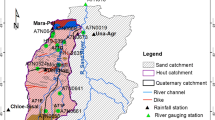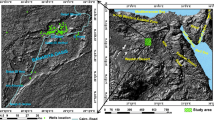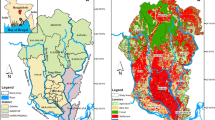Abstract
A coupled groundwater-flow-modelling and vulnerability-mapping methodology for the management of karst aquifers with spatial variability is developed. The methodology takes into consideration the duality of flow and recharge in karst and introduces a simple method to integrate the effect of temporal storage in the unsaturated zone. In order to investigate the applicability of the developed methodology, simulation results are validated against available field measurement data. The criteria maps from the PaPRIKa vulnerability-mapping method are used to document the groundwater flow model. The FEFLOW model is employed for the simulation of the saturated zone of Palaikastro-Chochlakies karst aquifer, in the island of Crete, Greece, for the hydrological years 2010–2012. The simulated water table reproduces typical karst characteristics, such as steep slopes and preferred drain axes, and is in good agreement with field observations. Selected calculated error indicators—Nash-Sutcliffe efficiency (NSE), root mean squared error (RMSE) and model efficiency (E′)—are within acceptable value ranges. Results indicate that different storage processes take place in different parts of the aquifer. The north-central part seems to be more sensitive to diffuse recharge, while the southern part is affected primarily by precipitation events. Sensitivity analysis is performed on the parameters of hydraulic conductivity and specific yield. The methodology is used to estimate the feasibility of artificial aquifer recharge (AAR) at the study area. Based on the developed methodology, guidelines were provided for the selection of the appropriate AAR scenario that has positive impact on the water table.
Résumé
Une méthodologie couplant la modélisation des écoulements souterrains et la cartographie de la vulnérabilité pour la gestion des aquifères karstiques considérant une variabilité spatiale a été développée. La méthodologie prend en compte la dualité des écoulements et de la recharge en milieu karstique et introduit une méthode simple pour intégrer l’effet du stockage temporaire dans la zone non saturée. Afin d’étudier l’applicabilité de la méthodologie développée, les résultats de la simulation sont validés en les confrontant aux données de terrain disponibles. Les cartes des critères de la méthode de cartographie de la vulnérabilité PaPRIKa sont utilisées pour renseigner le modèle d’écoulement des eaux souterraines. Le modèle FEFLOW a été utilisé pour simuler le comportement de la zone saturée de l’aquifère karstique de Palaikastro-Chochlakies sur l’île de Crète, en Grèce, pour les années hydrologiques 2010–2012. Le niveau piézométrique simulé reproduit les caractéristiques karstiques typiques, telles que des pentes raides et des axes de drainage préférentiels, et est en bon accord avec les observations de terrain. Les indicateurs d’erreurs calculés sélectionnées—l’efficacité Nash Sutcliffe (NSE), l’erreur quadratique moyenne (RMSE) et l’efficacité du modèle (E′)—se situent dans des plages de valeurs acceptables. Les résultats indiquent que les différents processus de stockage prennent place dans différentes parties de l’aquifère. La partie nord centrale semble plus sensible à la recharge diffuse, tandis que la partie sud est principalement affectés par des événements pluvieux. L’analyse de sensibilité est effectuée sur les paramètres de la conductivité hydraulique et du rendement spécifique. La méthodologie est utilisée pour estimer la faisabilité de la recharge artificielle de l’aquifère (AAR) dans la zone d’étude. Sur la base de la méthodologie développée, des lignes directrices ont été établies pour la sélection de scénarios d’AAR qui ont un impact positif sur le niveau piézométrique.
Resumen
Se desarrolla una metodología de modelación acoplada de flujo de agua subterránea y de mapeo de vulnerabilidad para el manejo de acuíferos kársticos con variabilidad espacial. La metodología toma en consideración la dualidad de flujo y recarga en el karst e introduce un método simple para integrar el efecto del almacenamiento temporal en la zona no saturada. Para investigar la aplicabilidad de la metodología desarrollada, los resultados de la simulación se validan con los datos de medición de campo disponibles. Los mapas de criterios del método de mapeo de vulnerabilidad PaPRIKa se usan para documentar el modelo de flujo de agua subterránea. El modelo FEFLOW se emplea para la simulación de la zona saturada del acuífero kárstico de Palaikastro-Chochlakies, en la isla de Creta, Grecia, para los años hidrológicos 2010–2012. El nivel freático simulado reproduce las características kársticas típicas, tales como pendientes empinadas y ejes de drenaje preferenciales, y está en buen acuerdo con las observaciones de campo. Los errores calculados de los indicadores—la eficiencia de Nash-Sutcliffe (NSE), la raíz del error cuadrático medio (RMSE) y la eficiencia del modelo (E′)—se encuentran dentro de rangos de valores aceptables. Los resultados indican que distintos procesos de almacenamiento tienen lugar en diferentes partes del acuífero. La parte centro norte parece ser más sensible a la recarga difusa, mientras que la parte sur se ve afectada principalmente por los episodios de la precipitación. Se realiza el análisis de sensibilidad sobre los parámetros de conductividad hidráulica y rendimiento específico. La metodología se utiliza para estimar la viabilidad de la recarga artificial de acuíferos (AAR) en el área de estudio. Basándose en la metodología desarrollada, se proporcionaron directrices para la selección del escenario adecuado de la AAR que tiene un impacto positivo en el nivel freático.
摘要
提出了针对具有空间变化性的岩溶含水层管理的地下水流模拟和脆弱性填图耦合的方法。该方法考虑了岩溶中水流和补给的二元性,引进了整合非饱和带时间上存储影响的一个简单方法。为了调查所提出方法的适用性,对照现有的野外测量数据对模拟结果进行了验证。通过PaPRIKa脆弱性填图方法得到的标准图用来证明地下水流模型。采用FEFLOW模型模拟了希腊克里特岛2010–2012水文年Palaikastro-Chochlakies岩溶含水层的饱和带。模拟的水位重现了典型的岩溶特征,如陡坡及优先排水轴,与野外观测结果高度吻合。所选的计算误差指标—Nash-Sutcliffe效率(NSE),根平均平方误差(RMSE)及模型效率(E′),都处在可接受值的范围内。结果显示,不同的储存过程发生在含水层的不同部位。中北部似乎对弥散补给更敏感,而南部主要受降水事件的影响。对水力传导率和单位出水量参数进行了灵敏度分析。该方法用于估算研究区人工含水层补给(AAR)的可能性。在开发的方法基础上,为选择对水位有正面影响的合适的人工含水层补给方案提供了指南。
Resumo
Foi desenvolvida uma metodologia acoplada de modelagem de fluxo de águas subterrâneas e de mapeamento de vulnerabilidade para gerenciamento de aquíferos cársticos com variabilidade espacial. A metodologia leva em consideração a dualidade de fluxo e de recarga em carste e introduz um método simples para integrar o efeito do armazenamento temporal na zona não saturada. Com o objetivo de investigar a aplicabilidade da metodologia desenvolvida, resultados de simulações são validados contra dados disponíveis de medições de campo. Os mapas de critérios do método de mapeamento de vulnerabilidades PaPRIKa são usados para documentar o modelo de fluxo de águas subterrâneas. O modelo FEFLOW é utilizado para a simulação da zona saturada do Aquífero Cárstico Palaikastro-Chochlakies, na ilha de Creta, Grécia, para os anos hidrológicos 2010–2012. O lençol freático simulado reproduz características típicas do cárste, como declives íngremes e eixos de drenagens preferidos, estando de acordo com as observações de campo. Indicadores selecionados de erros calculados—eficiência de Nash-Sutcliffe (ENS), raíz do erro quadrático médio (REQM) e eficiência de modelo (E′)—estão dentro de intervalos de valores aceitáveis. Os resultados indicam que diferentes processos de armazenamento acontecem em diferentes partes do aquífero. A parte norte-central parece ser mais sensível à recarga difusa, enquanto que a parte sul é afetada principalmente por eventos de precipitação. A análise de sensibilidade é feita nos parâmetros de condutividade hidráulica e rendimento específico. A metodologia é usada para estimar a viabilidade da recarga artificial do aquífero (RAA) na área de estudo. Com base na metodologia desenvolvida, foram estabelecidas orientações para a seleção do cenário apropriado de RAA que tenha impacto positivo no lençol freático.













Similar content being viewed by others
References
Andelman J, Bauwer H, Charbeneau R, Christman R, Crook J, Fan A, Yates M (1994) Groundwater recharge using waters of impaired quality. Natl. Academy Press, Washington, DC
Bakalowicz M (2005) Karst groundwater: a challenge for new resources. Hydrogeol J 13(1):148–160
Bauer S, Liedl R, Sauter M (2005) Modeling the influence of epikarst evolution on karst aquifer genesis: a time-variant recharge boundary condition for joint karst-epikarst development. Water Resour Res 41, W09416. doi:10.1029/2004WR003321
Birk S, Liedl R, Sauter M (2006) Karst spring responses examined by process-based modeling. Ground Water 44(6):832–836
Bouwer H (2002) Artificial recharge of groundwater: hydrogeology and engineering. Hydrogeol J 10(1):121–142
Charlier JB, Bertrand C, Mudry J (2012) Conceptual hydrogeological model of flow and transport of dissolved organic carbon in a small Jura karst system. J Hydrol 460:52–64
Chen Z, Goldscheider N (2014) Modeling spatially and temporally varied hydraulic behavior of a folded karst system with dominant conduit drainage at catchment scale, Hochifen-Gottesacker. Alps J Hydrol 514:41–52
Dafny E, Burg A, Gvirtzman H (2010) Effects of Karst and geological structure on groundwater flow: the case of Yarqon-Taninim Aquifer, Israel. J Hydrol 389:260–275
Daher W, Pistre S, Kneppers A, Bakalowicz M, Najem W (2011) Karst and artificial recharge: theoretical and practical problems—a preliminary approach to artificial recharge assessment. J Hydrol 408:189–202
de Rooij R, Perrochet P, Graham W (2013) From rainfall to spring discharge: coupling conduit flow, subsurface matrix flow and surface flow in karst systems using a discrete-continuum model. Adv Water Resour 61:29–41
Diersch HJG (2013) FEFLOW finite element subsurface flow and transport simulation system. User’s manual/reference manual/white papers, Release 6.2. WASY, Berlin
Dorfliger N, Plagnes V (2009) Cartographie de la vulnérabilité des aquifères karstiques guide méthodologique de la méthode PaPRIKa [Mapping the vulnerability of karst aquifers: guidelines of the method PaPRIKa]. Report BRGM RP-57527-FR, BRGM, Orleans, France, 100 pp
Fleury P, Plagnes V, Bakalowicz M (2007) Modelling of the functioning of karst aquifers with a reservoir model: application to Fontaine de Vaucluse (South of France). J Hydrol 345(1):38–49
Ford D, Williams PW (2007) Karst hydrogeology and geomorphology. Wiley, Chichester, UK
Goldscheider N, Drew DP (2007) Methods in karst hydrogeology. Taylor and Francis, London
Hugman R, Stigter T, Monteiro JP, Nunes L (2012) Influence of aquifer properties and the spatial and temporal distribution of recharge and abstraction on sustainable yields in semi-arid regions. Hydrol Process 26:2791–280. doi:10.1002/hyp.8353
Huneau F, Jaunat J, Kavouri K, Plagnes V, Rey F, Dörfliger N (2013) Intrinsic vulnerability mapping for small mountains karst aquifers, implementation of the new PaPRIKa method to Western Pyrenees (France). Eng Geol 161:81–93
Institute of Geology and Mineral Exploration of Greece (1959) Geological map of Greece. Map Sheet Ziros, scale 1:50.000. IGME, Athens
Institute of Geology and Mineral Exploration of Greece (2005) Hydrogeological study of the Prefecture of Lassithi. Report IGME, IGME, Athens, 243 pp
Jeannin PY (2001) Modeling flow in phreatic and epiphreatic karst conduits in the Holloch Cave (Muotatal, Switzerland). Water Resour Res 37:191–200
Jukić D, Denić-Jukić V (2009) Groundwater balance estimation in karst by using a conceptual rainfall–runoff model. J Hydrol 373(3–4):302–315
Kavouri K, Karatzas GP (2016) Integrating diffuse and concentrated recharge in karst models. Water Resour Manag. doi:10.1007/s11269-016-1528-y
Kavouri K, Plagnes V, Tremoulet J, Dörfliger N, Rejiba F, Marchet P (2011) PaPRIKa: a method for estimating karst resource and source vulnerability: application to the Ouysse karst system (southwest France). Hydrogeol J 19:339–353. doi:10.1007/s10040-010-0688-8
Kessler H (1965) Water balance investigation in the karstic region of Hungary. Proc. Assoc. Int. Hydrogeol. Sci. (A.I.H.S.), UNESCO Symp. on Hydrology of Fractured Rocks, Dubrovnik, Croatia, July 1965, pp 90–105
Király L (1998) Modelling karst aquifers by the combined discrete channel and continuum approach. Bull Centre Hydrogéol 1998(16):77–98
Király L (2002) Karstification and groundwater flow. In: Proc. of the conference Evolution of Karst: Prekarst to Cessation. Zalozba ZRC, Postojna-Ljubljana, Slowenia, pp 155–190
Ladouche B, Marechal JC, Dorfliger N (2014) Semi-distributed lumped model of a karst system under active management. J Hydrol 509:215–230
Le Moine N, Andréassian V, Mathevet T (2008) Confronting surface-and groundwater balances on the La Rochefoucauld-Touvre karstic system (Charente, France). Water Resour Res 44(3), W03403. doi:10.1029/2007WR005984
Liedl R, Sauter M, Hückinghaus D, Clemens T, Teutsch G (2003) Simulation of the development of karst aquifers using a coupled continuum pipe flow model. Water Resour Res 39(3):1057. doi:10.1029/2001WR001206
Mangin A (1975) Contribution à l’étude hydrodynamique des aquifères karstiques [Contribution to the hydrodynamic study of karstic aquifers]. PhD Thesis, Université de Dijon, France, 422 pp
Martínez-Santos P, Andreu JM (2010) Lumped and distributed approaches to model natural recharge in semiarid karst aquifers. J Hydrol 388(3–4):389–398
Moriasi DN, Arnold JG, Van Liew MW, Bingner RL, Harmel RD, Veith TL (2007) Model evaluation guidelines for systematic quantification of accuracy in watershed simulations. Trans ASABE 50(3):885–900
Papanikolaou D, Vassilakis E (2010) Thrust faults and extensional detachment faults in Cretan tectono-stratigraphy: implications for Middle Miocene extension. Tectonophysics 488:233–247
Perrin J, Jeannin PY, Zwahlen F (2003) Epikarst storage in a karst aquifer: a conceptual model based on isotopic data—Milandre test site, Switzerland. J Hydrol 279:106–124
Quinn J, Tomasko D, Kuiper A (2006) Modeling complex flow in karst aquifer. Sediment Geol 184:343–351
Scanlon BR, Mace RE, Barrett ME, Smith B (2003) Can we simulate regional groundwater flow in a karst system using equivalent porous media models? Case study, Barton Springs Edwards aquifer, USA. J Hydrol 276(1):137–158
Soulios G (1984) Infiltration efficace dans le karst hellénique [Effective infiltration into Greek karst]. J Hydrol 75:343–356
Teutsch G, Sauter M (1991) Groundwater modeling in karst terranes: scale effects, data acquisition and field validation. Proc. 3rd Conf. on Hydrogeology, Ecology, Monitoring and Management of Ground Water in Karst Terranes. Nashville, TN, December 1991, pp 17–38
Teutsch G, Sauter M (1998) Distributed parameter modelling approaches in karst-hydrological investigations. Bull Hydrogeol 16:99–109
Tritz S, Guinot V, Joudre H (2011) Modelling the behavior of a karst system catchment using non-liner hysteretic conceptual model. J Hydrol 397:250–262
Xanke J, Jourde H, Liesch T, Goldscheider N (2016) Numerical long-term assessment of managed aquifer recharge from a reservoir into a karst aquifer in Jordan. J Hydrol 540:603–614
Acknowledgements
This work is part of doctoral research conducted at the Technical University of Crete, Greece, in collaboration with Dr Valérie Plagnes from the Pierre and Marie Curie University, France. The contribution of Mr G. Koinakis, geologist at IGME, branch of Crete, is greatly appreciated. Software licensing for the FEFLOW model was kindly provided by DHI.
Author information
Authors and Affiliations
Corresponding author
Rights and permissions
About this article
Cite this article
Kavouri, K.P., Karatzas, G.P. & Plagnes, V. A coupled groundwater-flow-modelling and vulnerability-mapping methodology for karstic terrain management. Hydrogeol J 25, 1301–1317 (2017). https://doi.org/10.1007/s10040-017-1548-6
Received:
Accepted:
Published:
Issue Date:
DOI: https://doi.org/10.1007/s10040-017-1548-6




